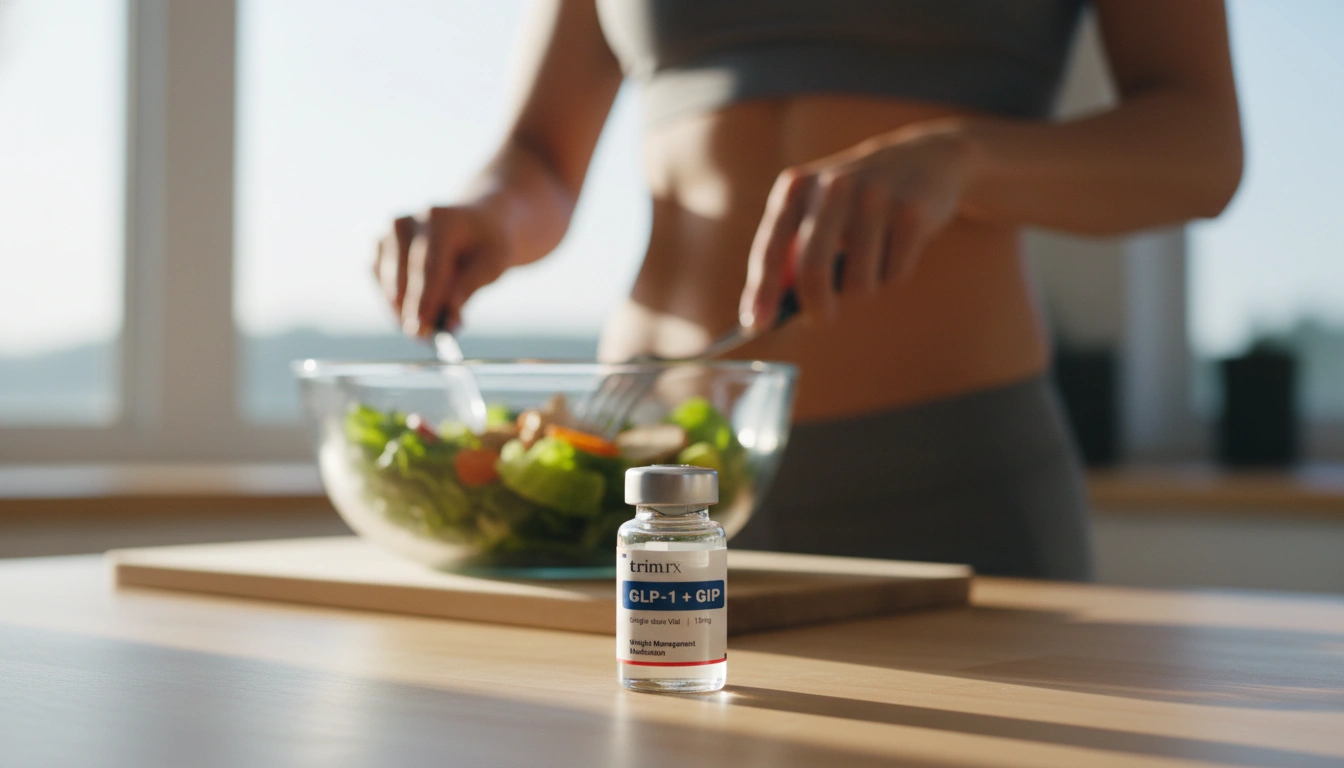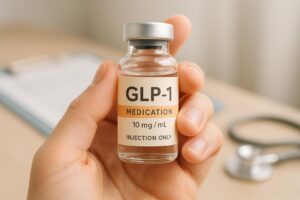How to Naturally Produce GLP-1: Your Guide to Enhancing Metabolic Health

Introduction
Have you ever wondered how the food you eat impacts your hormones and overall well-being? It’s more than just calories; the right foods can significantly influence our body’s hormone production, including glucagon-like peptide-1 (GLP-1). This remarkable hormone plays a crucial role in regulating appetite, blood sugar levels, and overall metabolism. In fact, understanding how to naturally produce GLP-1 could be a game-changer for those looking to manage their weight and enhance their metabolic health.
As we navigate the ever-evolving landscape of health and wellness, it’s essential to recognize the importance of GLP-1. This hormone is released from the gut in response to food intake, and it has become a focal point in recent discussions surrounding weight management and diabetes management. With the rise of GLP-1 medications like semaglutide and tirzepatide, many are eager to explore how they can increase their body’s natural production of this vital hormone.
In this blog post, we will delve into the intricacies of GLP-1, exploring its functions, the foods that can help boost its production, and lifestyle changes you can adopt for optimal gut health. We’ll also highlight how TrimRx’s approach to weight loss emphasizes personalized care and scientifically-backed solutions, paving the way for sustainable health transformations. Together, we will uncover practical strategies to enhance GLP-1 levels naturally, helping you take charge of your metabolic health.
The Importance of GLP-1
GLP-1 is not just another hormone; it’s a powerful regulator of our body’s metabolic processes. Produced in the gut, primarily in response to food intake, GLP-1 has several critical functions:
- Stimulates Insulin Secretion: GLP-1 enhances the secretion of insulin in a glucose-dependent manner, helping lower blood sugar levels after meals.
- Suppresses Appetite: It sends signals to the brain indicating fullness, which can lead to reduced food intake and support weight management.
- Slows Gastric Emptying: By delaying the emptying of the stomach, GLP-1 helps prevent sharp spikes in blood sugar levels.
- Inhibits Glucagon Secretion: This hormone reduces glucagon release, which is responsible for raising blood sugar levels.
With these functions in mind, it’s clear why increasing GLP-1 levels naturally can be beneficial for those looking to manage their weight and metabolism effectively.
How Does the Body Naturally Produce GLP-1?
Understanding how GLP-1 is produced in the body helps us appreciate the dietary and lifestyle choices that can enhance its levels. GLP-1 is primarily secreted by L-cells in the intestinal lining, and its release is triggered by the presence of certain nutrients in the gut. Here are some key factors that influence GLP-1 production:
- Dietary Fiber: Fiber is a crucial player in GLP-1 secretion. When we consume fiber-rich foods, our gut bacteria ferment this fiber, producing short-chain fatty acids (SCFAs) that stimulate GLP-1 release.
- Protein and Healthy Fats: Foods high in protein and healthy fats can also promote GLP-1 secretion. They take longer to digest, allowing for a gradual release of glucose into the bloodstream and a corresponding rise in GLP-1 levels.
- Gut Microbiome: The diversity and composition of our gut bacteria significantly influence GLP-1 production. A healthy gut microbiome, rich in beneficial bacteria, can enhance the release of GLP-1.
Foods That Increase GLP-1 Levels
Incorporating specific foods into your diet can help you naturally boost GLP-1 production. Let’s explore some of the most effective options:
1. High-Fiber Foods
Fiber plays a pivotal role in GLP-1 secretion. Here are some excellent sources:
- Whole Grains: Foods such as oats, barley, and whole wheat are rich in soluble fiber, which slows digestion and promotes GLP-1 release.
- Legumes: Beans, lentils, and chickpeas are fiber-rich options that can support GLP-1 levels while providing essential nutrients.
- Fruits and Vegetables: Apples, pears, broccoli, and Brussels sprouts are excellent choices. Their fiber content helps regulate blood sugar and can enhance GLP-1 secretion.
2. Protein Sources
Protein-rich foods are known to trigger GLP-1 release effectively:
- Eggs: Eggs are an excellent source of protein and healthy fats, making them a great addition to your meals.
- Lean Meats and Fish: Chicken, turkey, and fatty fish like salmon provide high-quality protein that supports satiety and GLP-1 production.
3. Healthy Fats
Incorporating healthy fats into your diet can also help enhance GLP-1 levels:
- Avocados: Rich in monounsaturated fats and fiber, avocados can promote fullness and support GLP-1 production.
- Nuts and Seeds: Almonds, walnuts, and chia seeds are packed with nutrients that can help regulate appetite and enhance GLP-1 levels.
4. Olive Oil
Extra virgin olive oil is not only a healthy fat but also promotes GLP-1 secretion. Using it in your cooking can provide both flavor and health benefits.
The Role of the Gut Microbiome
The gut microbiome—the collection of microorganisms inhabiting our digestive tract—plays a crucial role in the production of GLP-1. A diverse and balanced gut microbiome is essential for optimal GLP-1 levels. Here’s how you can support your gut health:
1. Embrace Prebiotics
Prebiotics are non-digestible fibers that feed beneficial gut bacteria. Foods like garlic, onions, asparagus, and bananas are excellent prebiotic sources that can help boost GLP-1 production by promoting a healthy gut environment.
2. Incorporate Probiotics
Probiotics are live beneficial bacteria that can enhance gut health. Specific strains, such as Bifidobacterium and Lactobacillus, have been shown to support GLP-1 production. You can find these in fermented foods like yogurt, kefir, and kimchi.
3. Maintain Gut Health
Keeping your gut balanced is vital for GLP-1 production. Here are some tips to support your gut health:
- Stay Hydrated: Adequate water intake is essential for digestion and nutrient absorption.
- Limit Processed Foods: Avoiding processed foods can help maintain a healthy gut microbiome, as these often contain additives that can disrupt gut health.
- Manage Stress: Stress can negatively affect gut health, so incorporating stress-reducing practices like mindfulness or yoga can be beneficial.
Lifestyle Changes to Boost GLP-1
In addition to dietary choices, certain lifestyle changes can enhance GLP-1 production:
-
Engage in Regular Exercise: Physical activity has been shown to increase GLP-1 levels. Aim for at least 150 minutes of moderate-intensity exercise each week, along with strength training exercises on two days.
-
Get Enough Sleep: Poor sleep can negatively affect hormone production, including GLP-1. Prioritize good sleep hygiene to support your overall hormonal balance.
-
Maintain a Healthy Weight: Achieving and maintaining a healthy weight can support optimal GLP-1 levels. If you’re struggling with weight management, consider taking our free assessment quiz to explore personalized weight loss solutions that align with your goals.
The TrimRx Approach to Weight Loss
At TrimRx, we believe in a personalized approach to weight loss, combining science, empathy, and transparency. Our programs are designed to help individuals embrace healthier lifestyles, guided by cutting-edge telehealth innovations and medically supervised care. By focusing on sustainable weight loss and individualized support, we aim to empower you on your journey toward better health.
Our comprehensive service includes doctor consultations, personalized treatment plans, lab work, and unlimited support, all delivered with no hidden fees. If you’re interested in exploring our prescription weight loss medications like compounded semaglutide or tirzepatide, we invite you to take our free assessment quiz to see if you qualify.
Additionally, we offer quick-access supplements such as our GLP-1 Daily Support and Weight Loss Boost, designed to complement your weight loss journey and support overall wellness. You can explore these options further by visiting our website.
Conclusion
Understanding how to naturally produce GLP-1 is essential for anyone looking to improve their metabolic health and manage their weight effectively. By incorporating fiber-rich foods, healthy fats, and protein into our diets, we can enhance GLP-1 levels and support our overall well-being.
Moreover, maintaining a healthy gut microbiome through prebiotics and probiotics, alongside lifestyle changes like regular exercise and adequate sleep, can further boost GLP-1 production. As we continue our journey toward better health, let’s embrace the power of nutrition and lifestyle to support our bodies’ natural processes.
If you’re ready to take the next step in your weight loss journey, consider taking our free assessment quiz and exploring the personalized solutions TrimRx has to offer. Together, we can work toward achieving your health goals and embracing a healthier, happier you.
FAQ
What is GLP-1 and why is it important?
GLP-1 (glucagon-like peptide-1) is a hormone produced in the gut that plays a crucial role in regulating insulin secretion, appetite, and gastric emptying. It helps manage blood sugar levels and can support weight management.
How can I naturally increase GLP-1 levels?
You can increase GLP-1 levels by consuming high-fiber foods, protein sources, healthy fats, and maintaining a balanced gut microbiome through prebiotics and probiotics. Regular exercise and adequate sleep also play a key role.
What foods should I eat to boost GLP-1?
Incorporate fiber-rich foods such as whole grains, legumes, fruits, and vegetables, as well as healthy fats from sources like avocados and nuts, and protein from lean meats and eggs.
Can lifestyle changes impact GLP-1 production?
Yes, lifestyle changes such as regular exercise, managing stress, and getting enough sleep can significantly enhance GLP-1 production and support overall metabolic health.
What support does TrimRx offer for weight loss?
At TrimRx, we provide personalized weight loss solutions, including prescription medications, doctor consultations, and comprehensive support to help you achieve your health goals sustainably.

Transforming Lives, One Step at a Time
Keep reading
Tracking Progress With GLP-1: What To Measure
Learn which metrics to track on GLP‑1 therapy—weight, waist, blood sugar, lipids, side effects, and non‑scale wins—and how often to monitor them.
Fatigue Solutions for Ozempic and Wegovy Users
Hydration, protein-rich meals, light activity, and better sleep can reduce medication-related fatigue and help maintain energy during weight-loss treatment.
GLP-1 Medication Side Effect Checker
Worried about GLP-1 medication side effects? Use our free checker for Semaglutide, Liraglutide, and more to learn what to expect and stay informed!



